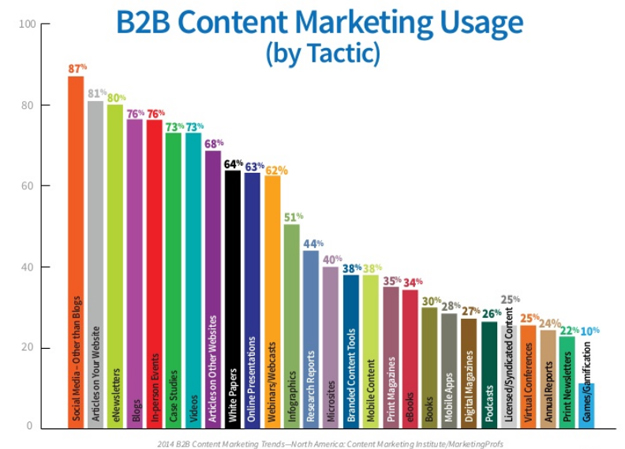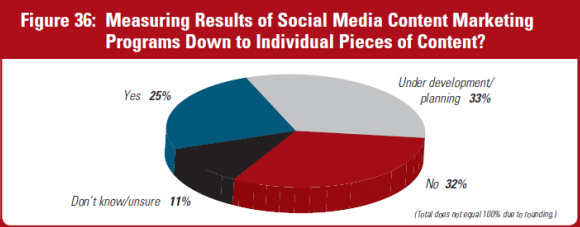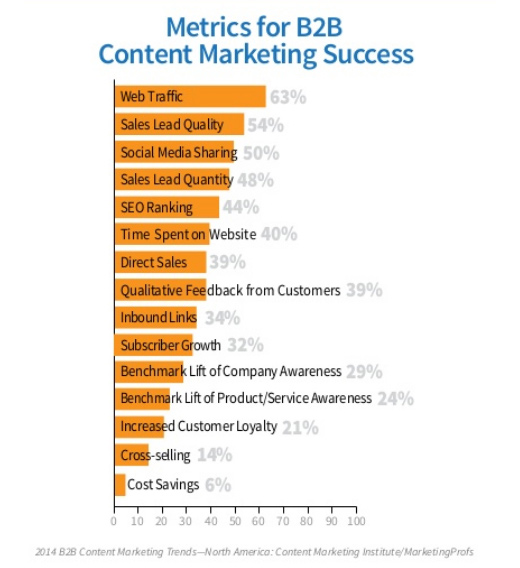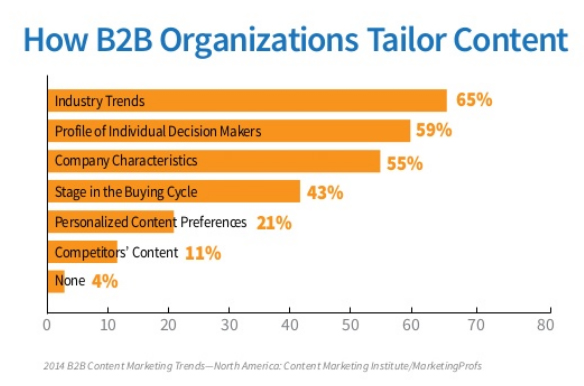According to a 2012 study by AOL and Nielsen, 27,000,000 pieces of content are shared every day. By now, the mantra of “content is king†has been relentlessly drilled into our collective heads – but more isn’t always necessarily better.
Quality is important – but how do you know if you’re really producing content that’s engaging your audience? Perhaps even more importantly, how are you measuring the results?
If you write and share it – will they come?
Let’s take a look at several new findings made as a result of a joint study between the Content Marketing Institute, MarketingProfs and Brightcove and what they could mean for next year’s content marketing trends.
Current Trend: Social Media, Newsletters and Blogs Head the Content Marketing Pack

Social media leads the way with 87% of B2B content marketers leveraging one or more platforms.
Not surprisingly, most marketers are promoting their content via social networks. Considering that clicks from shared sites are as much as five times more likely to be shared – it’s easy to see why. But at the same time, social media can seem like you’re marketing in an echo chamber. According to a MarketingLand survey, only 25% of marketers measure the ROI of their efforts down to the actual piece of content.
Most just seem to measure activity (likes/comments) if they measure anything at all – and that’s not giving them the raw data they need to know what’s real discussion, and what’s just background noise.

While nearly 50% of marketers surveyed had a content marketing plan – only 25% could accurately measure results down to the individual pieces of content.
What’s more, are people truly getting anything of value from the share itself (other than recognition from their friends/colleagues), or do they simply click and forget?
The Prediction:
I believe that in 2014, other content marketing avenues will overtake social media – including live events, case studies and (if companies can afford it), branded content tools. These things deliver much more value, brand awareness, backlinks and discussion than a simple social share – and in a marketing channel that’s already overcrowded, these tools present a chance for opportunistic businesses to approach customers from a newer, more helpful angle.
In addition, I predict that 2014 will see the rise of better measurement tools that don’t just track clicks and likes, but actual engagement in the form of discussion, shares across multiple platforms/channels, and actions as a result of those shares. Currently, it’s too cumbersome, expensive and time-consuming for a marketing team to micromanage the analytics for every single piece of content to see how it performed – so companies simply don’t invest in it.
Current Trend: How Brands Measure Success

According to the Content Marketing Institute study, most B2B companies measure success by the oldest internet metric in existence – traffic. But sheer numbers alone will only provide you with so much. Fortunately, sales lead quality ranks behind second, although it lags by almost 10%.
It’s difficult to measure intangible things like quality, but taking steps toward that goal, like creating personas for your target audience members, and matching those up with proper list segmentation can go a long way to putting a “face†with an interaction.
The Prediction:
This coming year, there will still be an emphasis on getting traffic, but many floundering websites are finally starting to wake up and smell the conversion coffee. Success will be measured according to the metrics that matter for that particular industry – whether it’s number of downloads, order volume, quality leads or a combination of those criteria.
Current Trend: What Type of Content is Created Most?

Industry Trends lead the way, with leadership profiles not far behind.
According to the chart above, content marketing focusing on industry trends are leading the way, with lesser degrees focusing on leadership profiles, company details, or even going so far as to try and play catch-up with competitors’ content. Industry trends could include breaking news, just-released software reviews, better practices or upcoming changes in the law or other facets of the business. Decision maker profiles could give readers a glimpse behind the scenes of the people who are leading the way in the aforementioned industry trends.
But if you look carefully at this chart – you’ll see that a lot of emphasis is placed on the company itself, industry methods, and people within the company.
STOP IT.
This is why most content marketing efforts are essentially spinning their wheels in the mud. Not a single one of these has anything to do with the real reason why people and businesses are consuming content:
Relevancy.
Keeping a finger on the pulse of news, learning about industry leaders and the companies they lead are all well and good – but none of these things get to the heard of what’s on every company and customer’s mind – What can this do for me?
The Prediction
In 2014, I’d expect to see this graph radically changed. Content needs to be tailored to fit the needs and unanswered questions of the target audience. Specifically:
-
Shift from industry news and trends to “Here’s how you can use these trends to grow your own business – and how our company can help.â€
-
Exchange profiles of decision makers to focus on customer/company success stories – detailed case studies that show a marked, measurable result.
-
In place of company characteristics, ask “Why should I trust you? What can you offer me that no one else can?â€
Tailoring content to where customers are in the buying cycle is a tried-and-true sales method, and I believe more and more marketing teams will take the time to properly engage their customers based on not only their place in the sales funnel, but their individual needs and expectations.
Again, we’re measuring many intangible, potentially unquantifiable things here – and it’s hard to pin down personalization and results into something as concrete as an analytical tool, but there’s no clearer route to earning a customer’s business, loyalty and trust.
At the same time, looking to a competitor’s content to see what steps to take is like the blind leading the blind. Do your own tests and use that data to understand what truly works for your website and your business.
Getting Ready for the Year Ahead
With all this information, how can you best prepare yourself for the year ahead?
-
Create your own Case Study – Not only is it a terrific resource for backlinks, but it also propels you on to becoming a recognized authority in your field.
-
Or Host a Live Event in Your Area – This is a great way to reach out to local businesses and entrepreneurs while sharing ideas and resources.
-
Look for Ways to Measure the Impact of Your Content Marketing – Not just in terms of raw numbers, but in the actions that occurred after the fact.
-
Refocus Content on the Consumer – Most content marketing is more marketing than content. How can consumers benefit from what you’re sharing? Why should they pay attention to it?
No One is Right Every Time
We may be completely blindsided by a new technology that brings us even closer to that marketing sweet-spot of connecting with buyers and persuading them to act. Until then, however, content marketing is one of the best ways to encourage engagement and interaction. We’ll look back at this article this time next year and see how right (or wrong) these predictions turned out to be!
Share Your Content Marketing Predictions for 2014!
Where do you think content marketing is headed? Share your own predictions in the comments!
By Sherice Jacob

